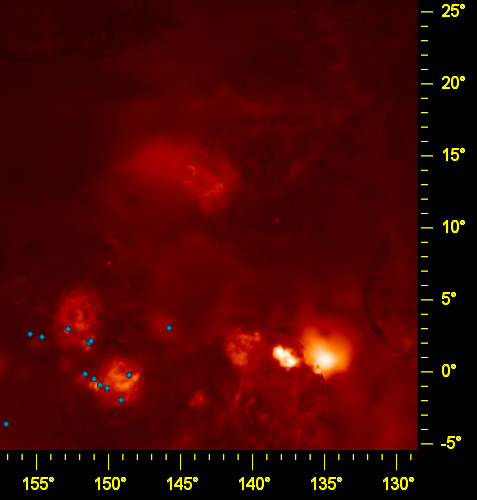
Hover your mouse over each blue dot for the name of the object, or click on the dot for a detail page. This map was created using the all-sky hydrogen-alpha map produced by Douglas Finkbeiner from data collected by the WHAM, VTSS and SHASSA hydrogen-alpha surveys.
The constellation Camelopardalis (the Giraffe) is often described as an empty window looking out beyond the Milky Way - a good place to find external galaxies. There are some thin dust clouds in this direction and two OB associations, the most prominent of which is Camelopardalis OB1 (associated with the nebula Sh 2-205 at 900 parsecs). A bright nebula illuminated by an O5-class star at 3700 parsecs, Sh 2-206, is visible behind Sh 2-205. Another prominent nebula that appears in the sky near Sh 2-205 is Sh 2-210, which is believed to lie at a distance of 2100 parsecs.
The bright nebulae on the right (west) side of the image belong to the Heart and Soul region.
There are several other nebulae in a similar direction to Camelopardalis OB1 and Sh 2-210 that appear over thousands of parsecs like islands in an otherwise empty bay. For example, Sh 2-204 lies at a distance of 4000 parsecs and Sh 2-209 is at distance of about 7800 parsecs. Very little is known about any of them.
The obvious nebula at (143.51°, -1.86°) is Sh 2-203 (and the nearby BFS 31) at 3500 parsecs, which seem to be connected to the OB association Camelopardalis OB3 in the remote outer galaxy. The blue dots for these objects have gone missing - I'll fix this eventually.
An intriguing feature of the Camelopardalis region is a huge nebula at high latitude that seems to have a "neck" connecting it to the galactic plane - arching over the Milky Way like a striking cobra. This nebula, called Vdb 30, is a warm dust cloud swept up by an intense wind blown from the runaway O9.5Iae supergiant binary star Alpha Camelopardalis, which is believed to lie at a distance of about 1100 parsecs and to have been blasted out of the star cluster NGC 1502 and high above the galactic plane by a supernova explosion about 2 million years ago. A shell in neutral (un-ionised) atomic hydrogen (called an HI region) has been known in this direction since the 1970s. This shell is usually known as GSH 148-01+15 and is believed to lie at a distance of 500 parsecs.
